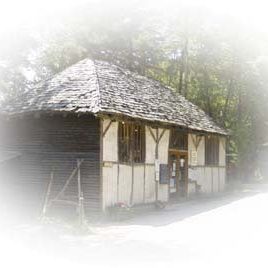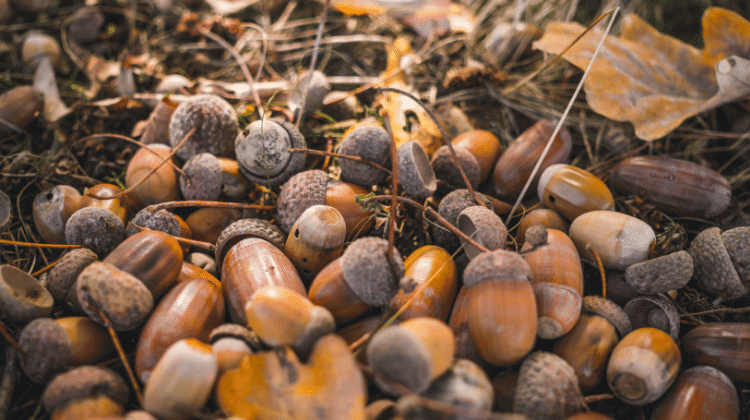Acorns are well-known as being a favourite meal for many woodland creatures. Mice, squirrels and birds all forage for these nutty treats throughout Autumn as they can be stored easily for eating during the cold winter months when food is scarce. But it’s not just wild animals that can eat acorns, we humans can eat them too. Below we will share some great acorn recipes, as well as a few more interesting facts about acorns.
Are Acorns Edible?
Raw acorns as they are found on the ground or on oak trees contain tannins, which can be toxic to humans and cause an unpleasant and bitter taste in the mouth. As well as being poisonous to humans, raw acorns are also poisonous to horses, cattle and dogs.
However, you can remove the tannins from acorns via a process known as leaching. Leaching can be done with either hot or cold water, depending on how you’d like to use the acorns afterwards. However you decide to leach your acorns, always ensure that they are fully ripened by ensuring that they have turned brown in colour. Also, remember to forage sustainably so that there are plenty of acorns left for the wildlife that relies on them.
Leaching Acorns
There are many reasons to leach acorns. Acorns – once leached- can be ground to make flour for bread, pancakes, pastries, cookies and even pasta. If you plan to use acorns to make flour then it’s best to leach with cold water. This is because it will preserve the natural starch found in the acorns and help the dough to hold itself together that much better. If you wish to keep your acrons whole or in large chunks, then it’s best to leach them with boiling water.
Either way, follow the below method to leach your acorns, using hot or cold water as required for your intended use of them:
- Shell the acorns. This can be quite a fiddly task, but once you’ve got the hang of it you will get quicker at it. Many people think that it’s easier if you freeze the acorns first, or use acorns that you have collected from previous years.
- Soak the shelled acorns in either hot or cold water, depending on what you wish to use them for.
- Once the water turns brown, drain it off and soak the acorns once more in fresh hot or cold water.
- Keep repeating this process until the water runs clear when draining.
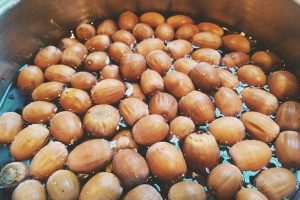 Roasted Acorns
Roasted Acorns
Salted nuts are a favourite among people who like a savoury snack. Roasting acorns makes a great savoury snack and is probably the easiest way to cook them. As well as enjoying them as a winter snack they can also be added to a winter stew.
- After leaching with hot water, place the damp chunks on to a baking tray and sprinkle with salt.
- Roast for 15 to 20 minutes on a high heat.
- The acorns will be ready when they appear to darken in colour
- Cool and enjoy!
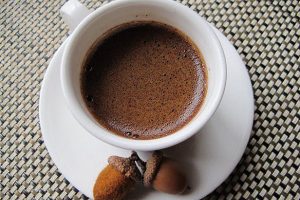 Acorn Coffee
Acorn Coffee
Acorn coffee is great because it’s caffeine free. It has its own unique taste that is somewhat different from traditional coffee, but it’s absolutely delicious and very warming.
- Leach acorns with hot water, then lay acorns in an ovenproof dish
- Dry slowly by roasting on a very low heat. Ideally this process should take more than a couple of hours.
- Ensure that you move the acorns around the dish regularly during the roasting process so that they don’t stick
- As the acorns dry they will start to turn brown. You can choose whether you prefer a light or a dark roast.
- Once roasted to how you want them, remove the acorns and cool them down.
- Grind them up and enjoy your acorn coffee!
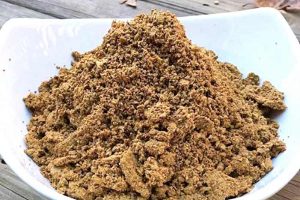 Acorn Flour
Acorn Flour
- When you shell acorns they easily turn a dark colour when they have been exposed to air. In keeping with the traditional flour colour, you may wish to shell your acorns straight into a bowl of water in order to preserve the light colour of them.
- Once you have shelled your acorns, grind, blitz or chop them into small pieces and then cover them with water. Leave the mixture in a bowl of cold water and change the water every day. After a few days the acorns will lose their bitterness and this is when you know that they have been fully leached.
- Dry the mix by straining it through a cheesecloth or muslin over a bowl. Squeeze the cloth to extract the water from it, and then discard the liquid.
- Tip the damp flour onto a baking tray and put in the oven on a very low heat to dry. This process should take a few hours.
- Once fully dried, put the acorns into a food blender and blitz until you get a fine, floury powder.
- Store the flour in the fridge or freezer. You can use acorn flour in exactly the same way that you would use ordinary wheat flour in baking and cooking.
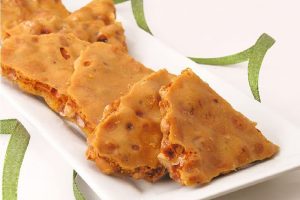 Acorn Brittle
Acorn Brittle
If you have a sweet tooth, then you will absolutely love acorn brittle. It’s more or less the same as peanut brittle, but using acorns instead of peanuts. To make this you will need 100g of caster sugar for every 100g of roasted acorns.
- Leach the acorns with hot water
- Tip the caster sugar into a saucepan and place on a low heat
- Shake the pan very gently when the sugar begins to melt and go dark in colour.
- When the sugar is a dark brown colour, add the acorns and stir gently
- Remove from the heat and pour into a baking tray that has been lined with greaseproof paper.
- Leave at room temperature to cool and eventually harden.
